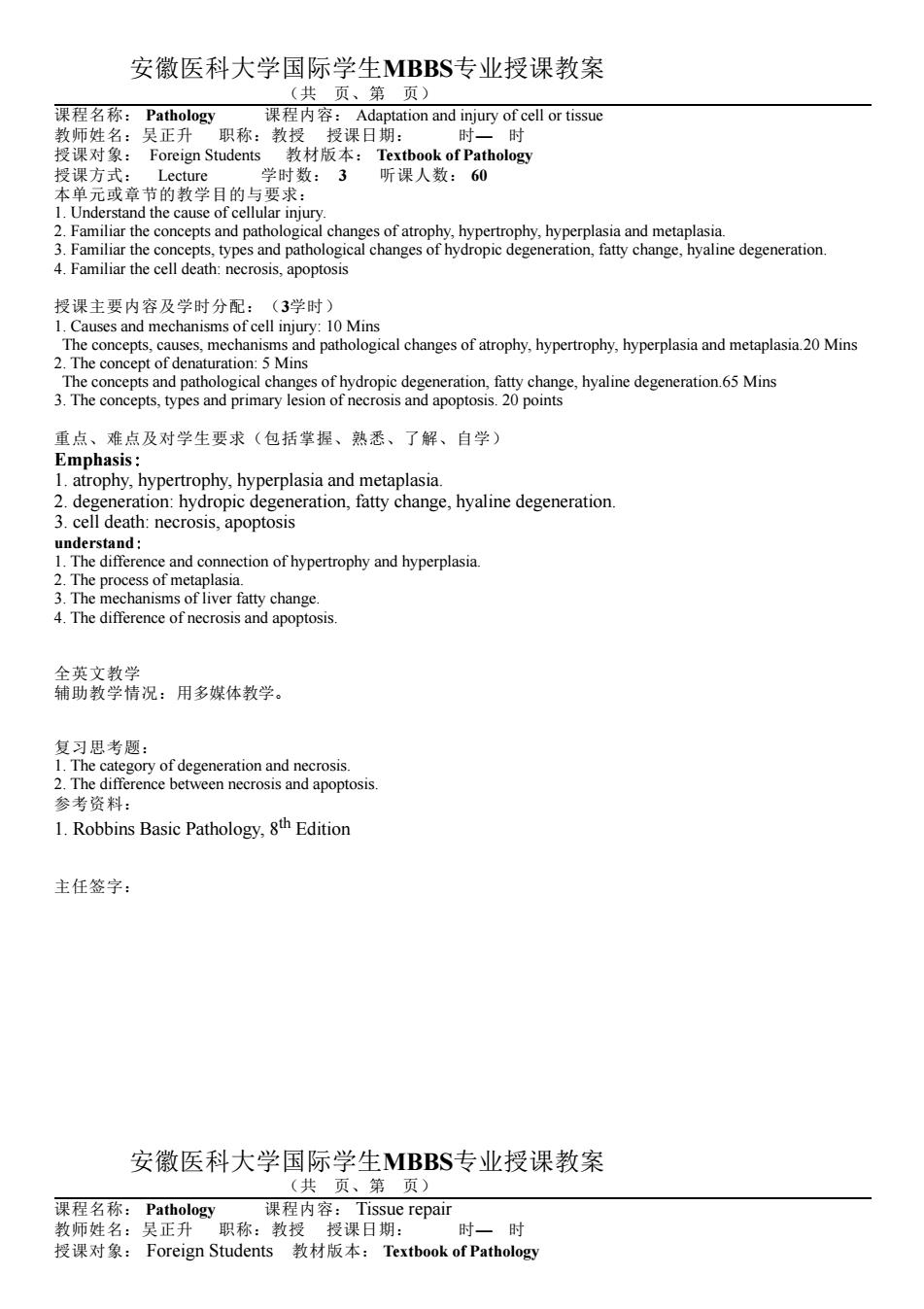
安徽医科大学国际学生MBBS专业授课教案 (共页、第页) 课程名称:Pathology 课程内容:Adaptation and injury of cell or tissue 教师姓名:吴正升职称:教授授课日期: 时一时 授课对象:Foreign Students教材版本:Textbook of Pathology 授课方式:Lecture 学时数:3听课人数:60 本单元或章节的教学目的与要求: 1.Understand the cause of cellular injury. 2.Familiar the concepts and pathological changes of atrophy,hypertrophy,hyperplasia and metaplasia. 3.Familiar the concepts,types and pathological changes of hydropic degeneration,fatty change,hyaline degeneration. 4.Familiar the cell death:necrosis,apoptosis 授课主要内容及学时分配:(3学时) 1.Causes and mechanisms of cell injury:10 Mins The concepts,causes,mechanisms and pathological changes of atrophy,hypertrophy,hyperplasia and metaplasia.20 Mins 2.The concept of denaturation:5 Mins The concepts and pathological changes of hydropic degeneration,fatty change,hyaline degeneration.65 Mins 3.The concepts,types and primary lesion of necrosis and apoptosis.20 points 重点、难点及对学生要求(包括掌握、熟悉、了解、自学) Emphasis: 1.atrophy,hypertrophy,hyperplasia and metaplasia. 2.degeneration:hydropic degeneration,fatty change,hyaline degeneration. 3.cell death:necrosis,apoptosis understand: 1.The difference and connection of hypertrophy and hyperplasia. 2.The process of metaplasia. 3.The mechanisms of liver fatty change. 4.The difference of necrosis and apoptosis. 全英文教学 辅助教学情况:用多媒体教学。 复习思考题: 1.The category of degeneration and necrosis. 2.The difference between necrosis and apoptosis. 参考资料: 1.Robbins Basic Pathology,8th Edition 主任签字: 安徽医科大学国际学生MBBS专业授课教案 (共页、第页) 课程名称:Pathology 课程内容:Tissue repair 教师姓名:吴正升职称:教授授课日期: 时一时 授课对象:Foreign Students教材版本:Textbook of Pathology
安徽医科大学国际学生MBBS专业授课教案 (共 页、第 页) 课程名称: Pathology 课程内容: Adaptation and injury of cell or tissue 教师姓名:吴正升 职称:教授 授课日期: 时— 时 授课对象: Foreign Students 教材版本: Textbook of Pathology 授课方式: Lecture 学时数: 3 听课人数: 60 本单元或章节的教学目的与要求: 1. Understand the cause of cellular injury. 2. Familiar the concepts and pathological changes of atrophy, hypertrophy, hyperplasia and metaplasia. 3. Familiar the concepts, types and pathological changes of hydropic degeneration, fatty change, hyaline degeneration. 4. Familiar the cell death: necrosis, apoptosis 授课主要内容及学时分配:(3学时) 1. Causes and mechanisms of cell injury: 10 Mins The concepts, causes, mechanisms and pathological changes of atrophy, hypertrophy, hyperplasia and metaplasia.20 Mins 2. The concept of denaturation: 5 Mins The concepts and pathological changes of hydropic degeneration, fatty change, hyaline degeneration.65 Mins 3. The concepts, types and primary lesion of necrosis and apoptosis. 20 points 重点、难点及对学生要求(包括掌握、熟悉、了解、自学) Emphasis: 1. atrophy, hypertrophy, hyperplasia and metaplasia. 2. degeneration: hydropic degeneration, fatty change, hyaline degeneration. 3. cell death: necrosis, apoptosis understand: 1. The difference and connection of hypertrophy and hyperplasia. 2. The process of metaplasia. 3. The mechanisms of liver fatty change. 4. The difference of necrosis and apoptosis. 全英文教学 辅助教学情况:用多媒体教学。 复习思考题: 1. The category of degeneration and necrosis. 2. The difference between necrosis and apoptosis. 参考资料: 1. Robbins Basic Pathology, 8th Edition 主任签字: 安徽医科大学国际学生MBBS专业授课教案 (共 页、第 页) 课程名称: Pathology 课程内容: Tissue repair 教师姓名:吴正升 职称:教授 授课日期: 时— 时 授课对象: Foreign Students 教材版本: Textbook of Pathology
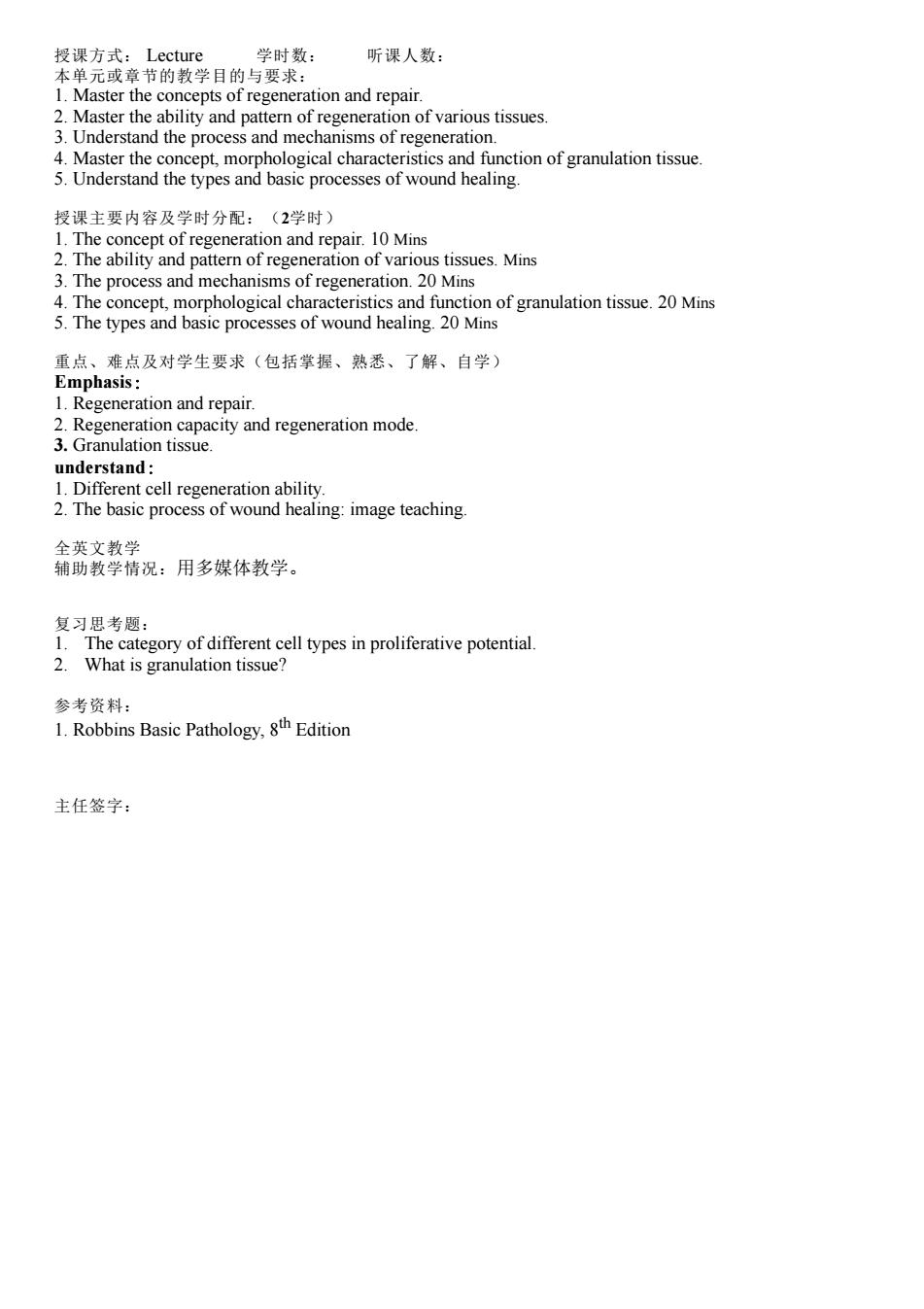
授课方式:Lecture 学时数: 听课人数: 本单元或章节的教学目的与要求: 1.Master the concepts of regeneration and repair. 2.Master the ability and pattern of regeneration of various tissues. 3.Understand the process and mechanisms of regeneration. 4.Master the concept,morphological characteristics and function of granulation tissue. 5.Understand the types and basic processes of wound healing 授课主要内容及学时分配:(2学时) 1.The concept of regeneration and repair.10 Mins 2.The ability and pattern of regeneration of various tissues.Mins 3.The process and mechanisms of regeneration.20 Mins 4.The concept,morphological characteristics and function of granulation tissue.20 Mins 5.The types and basic processes of wound healing.20 Mins 重点、难点及对学生要求(包括掌握、熟悉、了解、自学) Emphasis: 1.Regeneration and repair. 2.Regeneration capacity and regeneration mode. 3.Granulation tissue. understand 1.Different cell regeneration ability. 2.The basic process of wound healing:image teaching. 全英文教学 辅助教学情况:用多媒体教学。 复习思考题: 1.The category of different cell types in proliferative potential. 2.What is granulation tissue? 参考资料: 1.Robbins Basic Pathology,8th Edition 主任签字:
授课方式: Lecture 学时数: 听课人数: 本单元或章节的教学目的与要求: 1. Master the concepts of regeneration and repair. 2. Master the ability and pattern of regeneration of various tissues. 3. Understand the process and mechanisms of regeneration. 4. Master the concept, morphological characteristics and function of granulation tissue. 5. Understand the types and basic processes of wound healing. 授课主要内容及学时分配:(2学时) 1. The concept of regeneration and repair. 10 Mins 2. The ability and pattern of regeneration of various tissues. Mins 3. The process and mechanisms of regeneration. 20 Mins 4. The concept, morphological characteristics and function of granulation tissue. 20 Mins 5. The types and basic processes of wound healing. 20 Mins 重点、难点及对学生要求(包括掌握、熟悉、了解、自学) Emphasis: 1. Regeneration and repair. 2. Regeneration capacity and regeneration mode. 3. Granulation tissue. understand: 1. Different cell regeneration ability. 2. The basic process of wound healing: image teaching. 全英文教学 辅助教学情况:用多媒体教学。 复习思考题: 1. The category of different cell types in proliferative potential. 2. What is granulation tissue? 参考资料: 1. Robbins Basic Pathology, 8th Edition 主任签字:
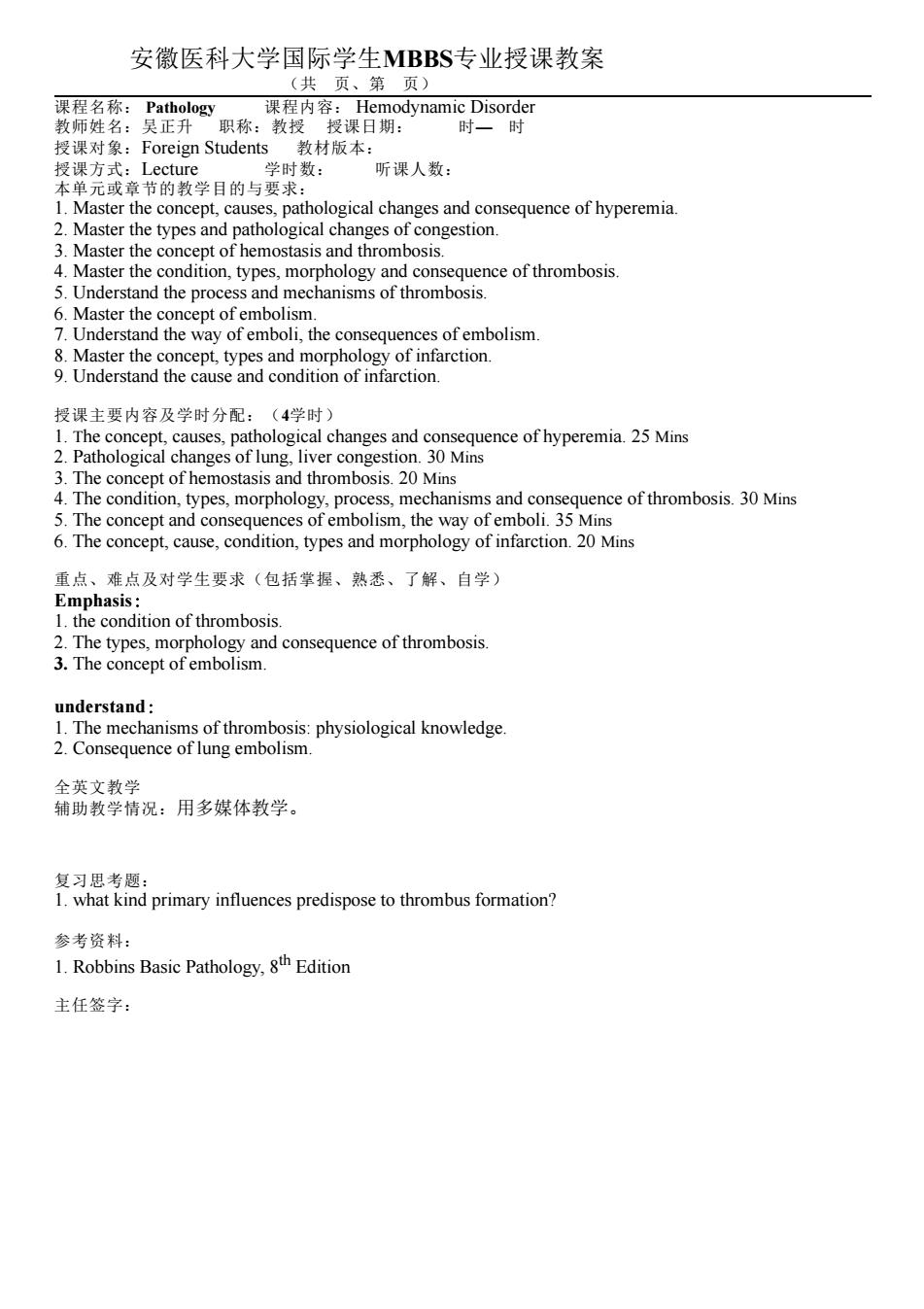
安徽医科大学国际学生MBBS专业授课教案 (共页、第页) 课程名称:Pathology 课程内容:Hemodynamic Disorder 教师姓名:吴正升职称:教授授课日期: 时一时 授课对象:Foreign Students教材版本: 授课方式:Lecture 学时数: 听课人数: 本单元或章节的教学目的与要求: 1.Master the concept,causes,pathological changes and consequence of hyperemia 2.Master the types and pathological changes of congestion. 3.Master the concept of hemostasis and thrombosis. 4.Master the condition,types,morphology and consequence of thrombosis. 5.Understand the process and mechanisms of thrombosis. 6.Master the concept of embolism. 7.Understand the way of emboli,the consequences of embolism. 8.Master the concept,types and morphology of infarction. 9.Understand the cause and condition of infarction. 授课主要内容及学时分配:(4学时) 1.The concept,causes,pathological changes and consequence of hyperemia.25 Mins 2.Pathological changes of lung,liver congestion.30 Mins 3.The concept of hemostasis and thrombosis.20 Mins 4.The condition,types,morphology,process,mechanisms and consequence of thrombosis.30 Mins 5.The concept and consequences of embolism,the way of emboli.35 Mins 6.The concept,cause,condition,types and morphology of infarction.20 Mins 重点、难点及对学生要求(包括掌握、熟悉、了解、自学) Emphasis: 1.the condition of thrombosis. 2.The types,morphology and consequence of thrombosis. 3.The concept of embolism. understand 1.The mechanisms of thrombosis:physiological knowledge. 2.Consequence of lung embolism. 全英文教学 辅助教学情况:用多媒体教学。 复习思考题: 1.what kind primary influences predispose to thrombus formation? 参考资料: 1.Robbins Basic Pathology,8th Edition 主任签字:
安徽医科大学国际学生MBBS专业授课教案 (共 页、第 页) 课程名称: Pathology 课程内容: Hemodynamic Disorder 教师姓名:吴正升 职称:教授 授课日期: 时— 时 授课对象:Foreign Students 教材版本: 授课方式:Lecture 学时数: 听课人数: 本单元或章节的教学目的与要求: 1. Master the concept, causes, pathological changes and consequence of hyperemia. 2. Master the types and pathological changes of congestion. 3. Master the concept of hemostasis and thrombosis. 4. Master the condition, types, morphology and consequence of thrombosis. 5. Understand the process and mechanisms of thrombosis. 6. Master the concept of embolism. 7. Understand the way of emboli, the consequences of embolism. 8. Master the concept, types and morphology of infarction. 9. Understand the cause and condition of infarction. 授课主要内容及学时分配:(4学时) 1. The concept, causes, pathological changes and consequence of hyperemia. 25 Mins 2. Pathological changes of lung, liver congestion. 30 Mins 3. The concept of hemostasis and thrombosis. 20 Mins 4. The condition, types, morphology, process, mechanisms and consequence of thrombosis. 30 Mins 5. The concept and consequences of embolism, the way of emboli. 35 Mins 6. The concept, cause, condition, types and morphology of infarction. 20 Mins 重点、难点及对学生要求(包括掌握、熟悉、了解、自学) Emphasis: 1. the condition of thrombosis. 2. The types, morphology and consequence of thrombosis. 3. The concept of embolism. understand: 1. The mechanisms of thrombosis: physiological knowledge. 2. Consequence of lung embolism. 全英文教学 辅助教学情况:用多媒体教学。 复习思考题: 1. what kind primary influences predispose to thrombus formation? 参考资料: 1. Robbins Basic Pathology, 8th Edition 主任签字:
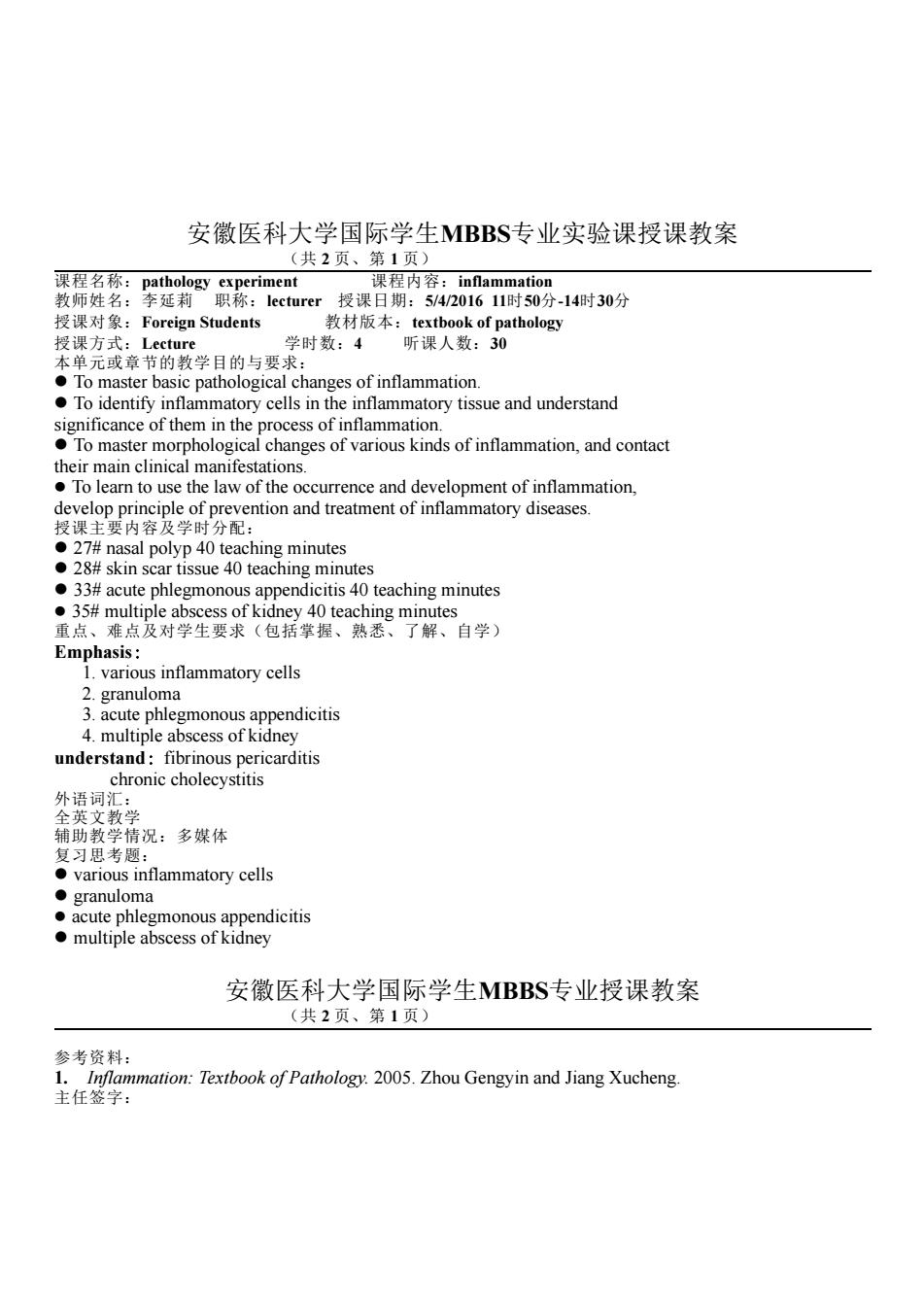
安徽医科大学国际学生MBBS专业实验课授课教案 (共2页、第1页) 课程名称:pathology experiment 课程内容:inflammation 教师姓名:李延莉职称:1 ecturer授课日期:5/4/201611时50分-14时30分 授课对象:Foreign Students 教材版本:textbook of pathology 授课方式:Lecture 学时数:4听课人数:30 本单元或章节的教学目的与要求: To master basic pathological changes of inflammation. To identify inflammatory cells in the inflammatory tissue and understand significance of them in the process of inflammation. To master morphological changes of various kinds of inflammation,and contact their main clinical manifestations. To learn to use the law of the occurrence and development of inflammation, develop principle of prevention and treatment of inflammatory diseases. 授课主要内容及学时分配: 27#nasal polyp 40 teaching minutes 28#skin scar tissue 40 teaching minutes 33#acute phlegmonous appendicitis 40 teaching minutes 35#multiple abscess of kidney 40 teaching minutes 重点、难点及对学生要求(包括掌握、熟悉、了解、自学) Emphasis: 1.various inflammatory cells 2.granuloma 3.acute phlegmonous appendicitis 4.multiple abscess of kidney understand:fibrinous pericarditis chronic cholecystitis 外语词汇: 全英文教学 辅助教学情况:多媒体 复习思考题: various inflammatory cells ●granuloma acute phlegmonous appendicitis multiple abscess of kidney 安徽医科大学国际学生MBBS专业授课教案 (共2页、第1页) 参考资料: 1.Inflammation:Textbook of Pathology.2005.Zhou Gengyin and Jiang Xucheng. 主任签字:
安徽医科大学国际学生MBBS专业实验课授课教案 (共 2 页、第 1 页) 课程名称:pathology experiment 课程内容:inflammation 教师姓名:李延莉 职称:lecturer 授课日期:5/4/2016 11时50分-14时30分 授课对象:Foreign Students 教材版本:textbook of pathology 授课方式:Lecture 学时数:4 听课人数:30 本单元或章节的教学目的与要求: l To master basic pathological changes of inflammation. l To identify inflammatory cells in the inflammatory tissue and understand significance of them in the process of inflammation. l To master morphological changes of various kinds of inflammation, and contact their main clinical manifestations. l To learn to use the law of the occurrence and development of inflammation, develop principle of prevention and treatment of inflammatory diseases. 授课主要内容及学时分配: l 27# nasal polyp 40 teaching minutes l 28# skin scar tissue 40 teaching minutes l 33# acute phlegmonous appendicitis 40 teaching minutes l 35# multiple abscess of kidney 40 teaching minutes 重点、难点及对学生要求(包括掌握、熟悉、了解、自学) Emphasis: 1. various inflammatory cells 2. granuloma 3. acute phlegmonous appendicitis 4. multiple abscess of kidney understand:fibrinous pericarditis chronic cholecystitis 外语词汇: 全英文教学 辅助教学情况:多媒体 复习思考题: l various inflammatory cells l granuloma l acute phlegmonous appendicitis l multiple abscess of kidney 安徽医科大学国际学生MBBS专业授课教案 (共 2 页、第 1 页) 参考资料: 1. Inflammation: Textbook of Pathology. 2005. Zhou Gengyin and Jiang Xucheng. 主任签字:
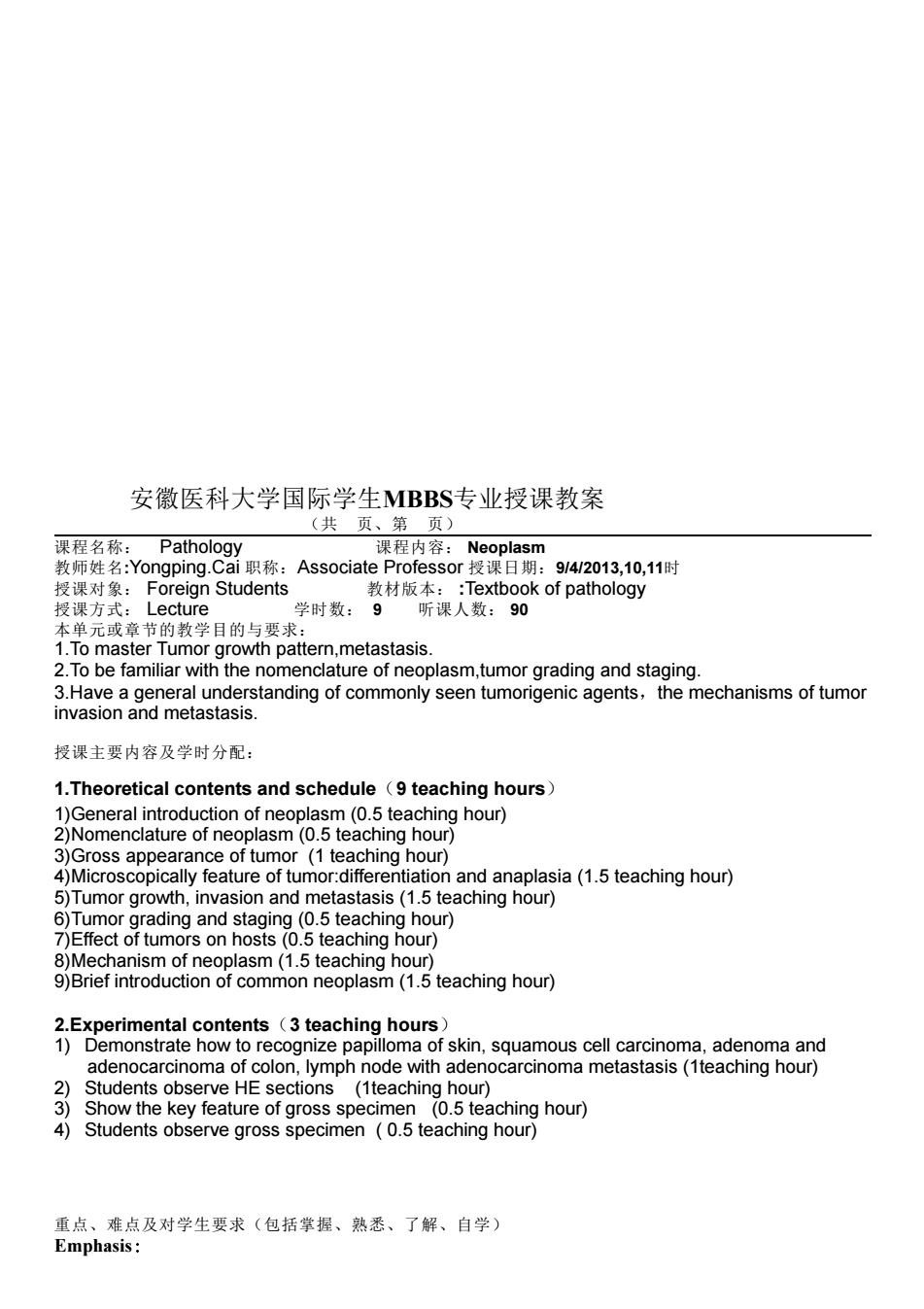
安徽医科大学国际学生MBBS专业授课教案 (共页、第页) 课程名称:Pathology 课程内容:Neoplasm 教师姓名:Yongping.Cai职称:Associate Professor授课日期:9/4/2013,10,11时 授课对象:Foreign Students 教材版本::Textbook of pathology 授课方式:Lecture 学时数:9听课人数:90 本单元或章节的教学目的与要求: 1.To master Tumor growth pattern,metastasis. 2.To be familiar with the nomenclature of neoplasm,tumor grading and staging. 3.Have a general understanding of commonly seen tumorigenic agents,the mechanisms of tumor invasion and metastasis. 授课主要内容及学时分配: 1.Theoretical contents and schedule (9 teaching hours) 1)General introduction of neoplasm(0.5 teaching hour) 2)Nomenclature of neoplasm(0.5 teaching hour) 3)Gross appearance of tumor (1 teaching hour) 4)Microscopically feature of tumor:differentiation and anaplasia(1.5 teaching hour) 5)Tumor growth,invasion and metastasis(1.5 teaching hour) 6)Tumor grading and staging(0.5 teaching hour) 7)Effect of tumors on hosts(0.5 teaching hour) 8)Mechanism of neoplasm(1.5 teaching hour) 9)Brief introduction of common neoplasm(1.5 teaching hour) 2.Experimental contents (3 teaching hours) 1)Demonstrate how to recognize papilloma of skin,squamous cell carcinoma,adenoma and adenocarcinoma of colon,lymph node with adenocarcinoma metastasis(1teaching hour) 2) Students observe HE sections (1teaching hour) 3)Show the key feature of gross specimen (0.5 teaching hour) 4)Students observe gross specimen (0.5 teaching hour) 重点、难点及对学生要求(包括掌握、熟悉、了解、自学) Emphasis:
安徽医科大学国际学生MBBS专业授课教案 (共 页、第 页) 课程名称: Pathology 课程内容: Neoplasm 教师姓名:Yongping.Cai 职称:Associate Professor 授课日期:9/4/2013,10,11时 授课对象: Foreign Students 教材版本: :Textbook of pathology 授课方式: Lecture 学时数: 9 听课人数: 90 本单元或章节的教学目的与要求: 1.To master Tumor growth pattern,metastasis. 2.To be familiar with the nomenclature of neoplasm,tumor grading and staging. 3.Have a general understanding of commonly seen tumorigenic agents,the mechanisms of tumor invasion and metastasis. 授课主要内容及学时分配: 1.Theoretical contents and schedule(9 teaching hours) 1)General introduction of neoplasm (0.5 teaching hour) 2)Nomenclature of neoplasm (0.5 teaching hour) 3)Gross appearance of tumor (1 teaching hour) 4)Microscopically feature of tumor:differentiation and anaplasia (1.5 teaching hour) 5)Tumor growth, invasion and metastasis (1.5 teaching hour) 6)Tumor grading and staging (0.5 teaching hour) 7)Effect of tumors on hosts (0.5 teaching hour) 8)Mechanism of neoplasm (1.5 teaching hour) 9)Brief introduction of common neoplasm (1.5 teaching hour) 2.Experimental contents(3 teaching hours) 1) Demonstrate how to recognize papilloma of skin, squamous cell carcinoma, adenoma and adenocarcinoma of colon, lymph node with adenocarcinoma metastasis (1teaching hour) 2) Students observe HE sections (1teaching hour) 3) Show the key feature of gross specimen (0.5 teaching hour) 4) Students observe gross specimen ( 0.5 teaching hour) 重点、难点及对学生要求(包括掌握、熟悉、了解、自学) Emphasis: